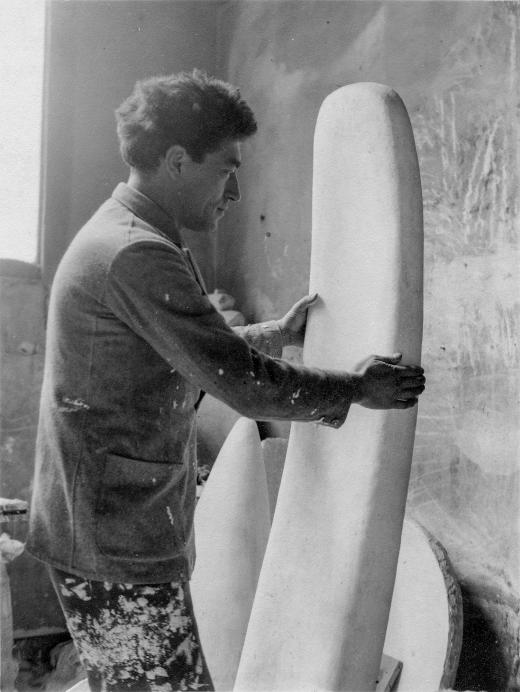
In December 1926, Alberto Giacometti occupied what was to become his studio until the end of his life. It was a rented 23 m2 space on the Rue Hippolyte-Maindron, near Montparnasse. One of his brothers, Diego, joined him in 1929 and became his assistant. Among other duties, Diego took charge of making the pedestals and metal structures on which Alberto created his plaster sculptures, and of applying the patina to his bronzes.
The studio was a tiny, narrow, and uncomfortable room with some small annexes where the Giacometti brothers lived. Books, paintings, drawings, and plaster sculptures were heaped up everywhere, and there was so little space that the artist sometimes had to take the sculptures out to the street to reflect on their scale. Giacometti frequently noted down ideas or made sketches directly on the walls. In the portraits and other paintings he produced there, the grayish daylight that filtered through the windows is clearly appreciable. His palette consisted mostly of grays and ochers with the occasional reddish touch. To feed his creative obsession, the artist constantly asked his friends (including intellectuals like Simone de Beauvoir, Jean-Paul Sartre and Isaku Yanaihara) and family (his brother Diego or his wife Annette) to sit for him. In 1932, for instance, he did two drawings for Donna Madina Gonzaga, an Italian aristocrat he had befriended, in the background of which it is possible to make out many of the pieces the artist had made during that period, and others he was then working on. Among them are two major works that currently form part of the Guggenheim Collections, Spoon Woman (1926–27, cast in 1954) and Walking Woman (1932).
In 1942, World War II drove Giacometti away from Paris to Geneva. Diego took care of keeping the atelier exactly as the artist had left it until his return in 1945. Although he was by now an acclaimed artist with some spending power, he never left that studio because he felt a special attachment to it. Despite its small size, the sculptor in fact once claimed that the longer he spent in it, “the bigger it got.”
After Giacometti’s death in 1966, the studio returned to its owner, but Annette, the artist’s widow, kept everything that had belonged there, including the painted walls, the furnishings, and the artworks that took up nearly every inch of that tiny space. Last June, the Institut Giacometti was inaugurated in Paris. It contains a reconstruction of the studio that was made possible by the pieces his widow had preserved.
Alberto Giacometti in the studio, holding one element of Projet pour une place, ca. 1932
Anonymous photograph
Collection Fondation Giacometti, Paris
